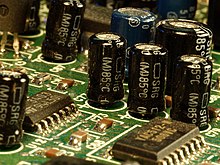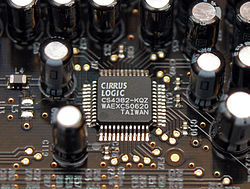General characteristics

Sound cards usually feature a digital-to-analog converter (DAC), which converts recorded or generated digital data into an analog format. The output signal is connected to an amplifier, headphones, or external device using standard interconnects, such as a TRS connector or an RCA connector. If the number and size of connectors is too large for the space on the backplate the connectors will be off-board, typically using a breakout box, or an auxiliary backplate. More advanced cards usually include more than one sound chip to provide for higher data rates and multiple simultaneous functionality, eg between digital sound production and synthesized sounds (usually for real-time generation of music and sound effects using minimal data and CPU time). Digital sound reproduction is usually done with multi-channel DACs, which are capable of multiple digital samples simultaneously at different pitches and volumes, or optionally applying real-time effects like filtering or distortion. Multi-channel digital sound playback can also be used for music synthesis when used with a compliance, and even multiple-channel emulation. This approach has become common as manufacturers seek to simplify the design and the cost of sound cards.
Sound channels and polyphony
An important characteristic of sound cards is polyphony, which is more than one distinct voice or sound playable simultaneously and independently, and the number of simultaneous channels. These are intended as the number of distinct electrical audio outputs, which may correspond to a speaker configuration such as 2.0 (stereo), 2.1 (stereo and sub woofer), 5.1 etc. Sometimes, the terms "voices" and "channels" are used interchangeably to indicate the degree of polyphony, not the output speaker configuration.
For example, many older sound chips could accommodate three voices, but only one audio channel (ie, a single mono output) for output, requiring all voices to be mixed together. Later cards, such as the AdLib sound card, had a 9 voice polyphony and 1 mono channel as a combined output.
For some years, most PC sound cards have had multiple FM synthesis voices (typically 9 or 16) which were usually used for MIDI music. The full capabilities of advanced cards aren't often completely used; only one (mono) or two (stereo) voice(s) and channel(s) are usually dedicated to playback of digital sound samples, and playing back more than one digital sound sample usually requires a software downmix at a fixed sampling rate. Modern low-cost integrated soundcards (ie, those built into motherboards) such as audio codecs like those meeting the AC'97 standard and even some budget expansion soundcards still work that way. They may provide more than two sound output channels (typically 5.1 or 7.1 surround sound), but they usually have no actual hardware polyphony for either sound effects or MIDI reproduction, these tasks are performed entirely in software. This is similar to the way inexpensive softmodems perform modem tasks in software rather than in hardware).

Tidak ada komentar:
Posting Komentar